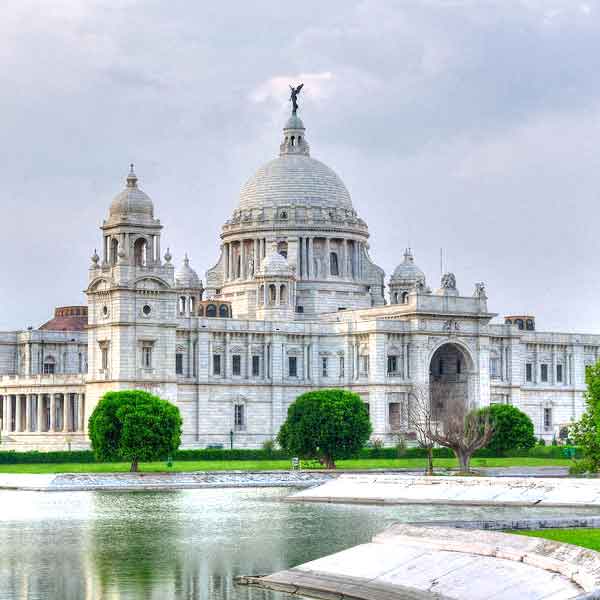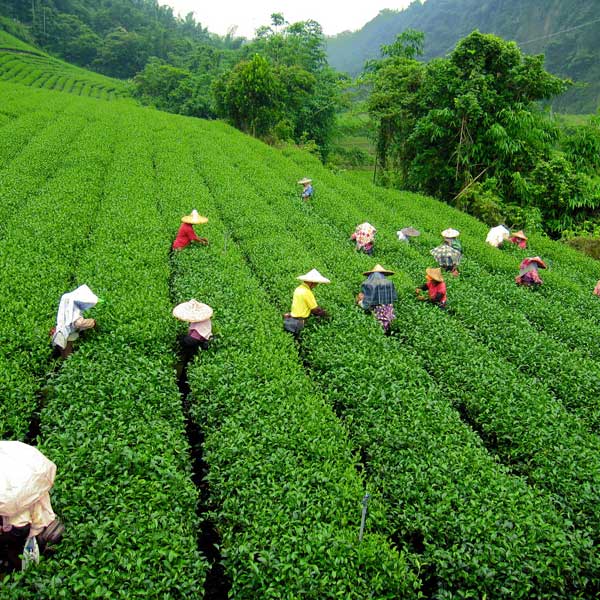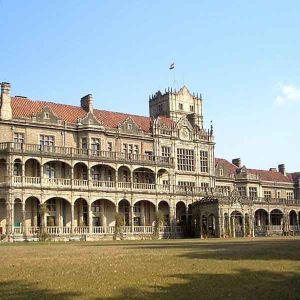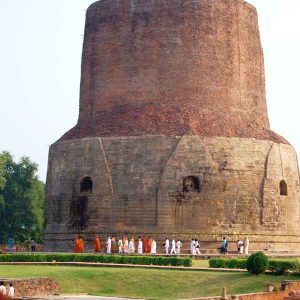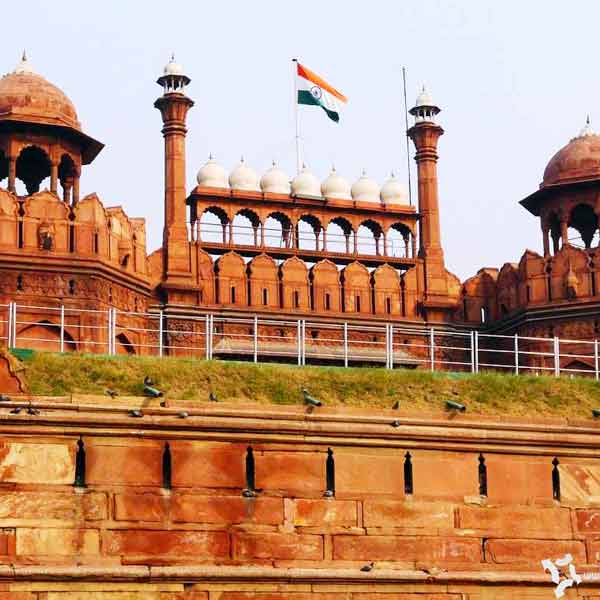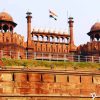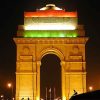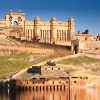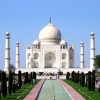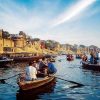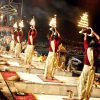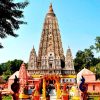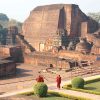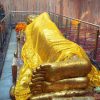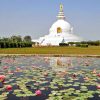Day 01: Arrive in Delhi.
On arrival into Delhi airport, you will be met by our representative, and then transferred to your hotel. Rest of day will be free. Overnight in Delhi.
Day 02: In Delhi.
After breakfast, set off for full-day tour of Delhi. Drive by India Gate, the Presidential Palace, lunch en-route, and then on to Old Delhi – visit impressive Red Fort, a UNESCO World Heritage site – a symbol of India’s Mughal past, and now of India’s sovereignty. Immerse yourself in the chaos of Chandni Chowk on cycle-rickshaw. Visit the Qutub Minar, a symbol of Mughal rule in India. Later in the day, stroll around magnificent Humayun’s Tomb and its gardens, and watch it change colour as the sun starts to set. Evening to relax and enjoy sumptuous Indian cuisine.
The India Gate in New Delhi (All India War Memorial) is at the eastern end of Rajpath and is similar to the ‘Arc de Triumph’. 42 metres high, it was built in memory of 90,000 soldiers who lost their lives in World War I and the Northwest Frontier operations in the Afghan war in 1919. The Presidential Palace, Rashtrapati Bhavan, is the official residence of the Indian president. Designed by Lutyens, a British architect, it was completed in 1929, mixing british architecture with Indian decoration. The Red Fort (Lal Qila) was built between 1638 and 1648 by Emperor Shah Jahan in order to display his wealth and power. The fort walls are 2km long and vary from 18 to 30 metres in height. The Humayun’s Tomb is of the Mughal era, built in 16th century by Haji Begum, senior wife of the second Mughal emperor Humayun. Overnight in Delhi.
Day 03: Delhi to Jaipur.
Drive to Jaipur and hotel check in on arrival. Day free for independent activities. Overnight in Jaipur.
Day 04: In Jaipur.
The fabled “Pink City” of Jaipur is the vibrant, bustling and immensely colourful capital of Rajasthan. The “pink” is derived from the rich hues of the architecture, constructed from rare coloured sandstone. Two and a half centuries ago, Jaipur was the country’s first modern city, laid strictly according to the ancient Indian treatise of town planning and architecture – the Shilpa Shastra. Structured in a nine-grid plan, it has City Palace in its centre, with mansions and markets emanating outward from this core. Many of those well-preserved palaces and mansions are now museums, or heritage hotels, making Jaipur one of the few big cities in India where walking around is a sheer pleasure.
Morning guided tour of Amber Fort. Afternoon, visit Hawa Mahal (Palace of Winds), Jantar Mantar and City Palace. Evening visit to Johri Bazar for shopping. Overnight in Jaipur.
Day 05: Jaipur to Agra.
Early morning drive to Agra, en route visiting Fatehpur Sikri. Fatehpur Sikri is regarded as Mughal Emperor Akbar’s crowning architectural legacy. Its numerous palaces, halls, and masjids (mosques) display his creative and aesthetic impulses, typical of Mughals.
Hotel check in on arrival in Agra. The architectural splendor of the mausoleums, the fort and the palaces is a vivid reminder of the opulence of the legendary Mughal Empire, of which Agra was the capital in the 16th and early 17th century. While its significance as a political centre ended with the transfer of the capital to Delhi in 1634 by Shah Jahan, its architectural wealth has secured its place on the international map.
Afternoon visit Taj Mahal and Red Fort. Overnight in Agra.
Day 06: Agra to Varanasi.
Morning transfer to Railway station to board train for Varanasi. Hotel check in on arrival. Overnight in Varanasi.
Day 07: In Varanasi.
Located on the banks of the mighty Ganges, the holy city of Varanasi, one of the oldest in India, embodies much of the myth and culture of Hinduism and has been a centre for the worship of Shiva for over 1200 years. Many believe that this is the site where the spiritual and material worlds collide, affording it a mystic property that is enhanced by the countless thousands of devotees who journey here to bathe in the scared waters of the River Ganges. Varanasi cannot be described – it can only be experienced.
Dawn boat ride on the Ganges followed by city tour visiting Vishwanath Temple and Bharat Mata Temple etc. Afternoon excursion to Sarnath (closed Fridays), where Lord Buddha first preached the Dharma after attaining enlightenment in Bodhgaya. Today it presents the most expansive ruins amongst places on the Buddhist trail. At Sarnath visit Dhamek Stupa – which is now an official symbol of Modern India. Chaukandi Stupa – this stupa was rebuilt by Mughal Emperor Akbar. Dhamarajika Stupa – only the ruins of this stupa built by Emperor Ashoka can be seen today. Moolgandha Kuti Vihara – built in more recent times by the Mahabodhi Society, it has a life-size statue of the lord Buddha in the Dharmachakra Pravartan form. Overnight in Varanasi.
Day 08: Varanasi to Bodhgaya.
Morning drive to Bodhgaya. Hotel check in on arrival.
Bodhgaya is one of the most important and sacred Buddhist pilgrimage center in the world. It was here under a banyan tree, the Bodhi Tree, Gautama attained supreme knowledge to become Buddha the Enlightened One. Visit Mahabodhi Temple and other important temples in Bodhgaya. In Bodhgaya, the Mahabodhi (“Great Enlightenment”) Temple is a Buddhist stupa. It’s located in the centre of Bodhgaya, and is regarded as the most sacred site in Buddhism. It is visited regularly by both Buddhist and Hindu pilgrims (many Hindus honor the Buddha as an incarnation of Vishnu). It is a truly enriching experience to see pilgrims from the world over intent on performing meritorious acts, meditating, lighting votive candles, telling their prayer beads or just quietly walking in calm and delight.
The Bodhi Tree (“Tree of Awakening,” also known as the Bodhi Tree) in Bodhgaya is a direct descendent of the tree under which Siddhartha Gautama is attained enlightenment. After 49 days of meditation, it was here that Siddhartha Gautama became the Buddha, the “Enlightened One.” Overnight in Bodhgaya.
Day 09: Bodhgaya to Patna via Rajgir & Nalanda.
Drive to Patna en route visiting Rajgir. Rajgir is a site of great sanctity and significance of Buddhists. The Gridhakuta Hill, in Rajgir, was the seat from where Buddha delivered many of his sermons.
Proceed to Nalanda. Nalanda is widely regarded as “one of the first great universities in recorded history” of the world and it attracted students from the whole of Asia and as far as Japan, Indonesia, Greece and Persia. The Nalanda university flourished between 427 to 1197 CE (i.e. 427 to 1197 AD) and it was the largest residential centre of learning that the world had ever known. It was an education center even during the time of Gautam Buddha and Buddha is mentioned as having several times stayed at Nalanda.
On arrival in Patna hotel check in. Rest of the day free at leisure. Overnight in Patna.
Day 10: Patna to Kushinagar.
Morning drive to Kushinagar en route visiting Vaishali. At Kolhua, Lord Buddha delivered his last sermon, hinting at his impending departure from the mortal world. Later, Emperor Ashoka erected a huge pillar to commemorate the spot of the last sermon.
Proceed to Kushinagar and check into the hotel on arrival. Overnight in Kushinagar.
Day 11: Kushinagar to Lumbini.
Kushinagar is revered as the site of the Buddha’s ‘Mahaparinirvana’, his death and cremation, that marked his final liberation from the cycles of death and rebirth. Morning, guided tour of Kushinagar. Later drive to Lumbini. Hotel check in on arrival. Overnight in Lumbini.
Day 12: Lumbini to Balrampur.
Lumbini is believed to be the birth place of Buddha. The central landmark here is the Mayadevi Temple, named after Buddha’s mother Queen Mahamaya or Maya Devi. Next to the temple is a pillar erected by KIng Ashoka to mark this sacred spot. The pool next to the Mahamaya temple is where Buddha’s mother is said to have bathed after giving birth to him.
Morning guided tour of Lumbini. Later drive to Balrampur en route visiting Kapilavastu. It was in Kapilavastu’s opulent environs, that prince Siddharth (Gautam Buddha) spent his childhood. Here he saw sorrow and pain, disease and death. Then, finally when he saw a radiant happy Sadhu who had conquered all these, he decided to renounce all worldly riches and pleasures to seek truth and embark on the path of salvation.
Proceed to Sravasti. According to the history of Buddhism, it was at Sravasti that Lord Buddha performed many miracles to confound his critics. Proceed to Balrampur. Hotel check in on arrival in Balrampur. Overnight in Balrampur.
Day 13: Balrampur to Lucknow.
Balrampur is an important town assocciated with holy Buddhist and Jain sites. There are a lot of Buddhist monasteries and ruins that attract hordes of tourists from different parts of India.
Morning guided tour of Balrampur. Later drive to Lucknow and check in to the hotel in arrival. Overnight in Lucknow.
Day 14: Lucknow to Delhi. Depart Delhi.
Morning guided tour of Lucknow. Later transfer to the Airport to board flight for Delhi. On arrival, transfer to the Airport for flight back home.
Date and price to suit individual arrangements based on 2 people sharing. Breakfast included. Private air-conditioned car and driver with English speaking guides for sightseeing.

